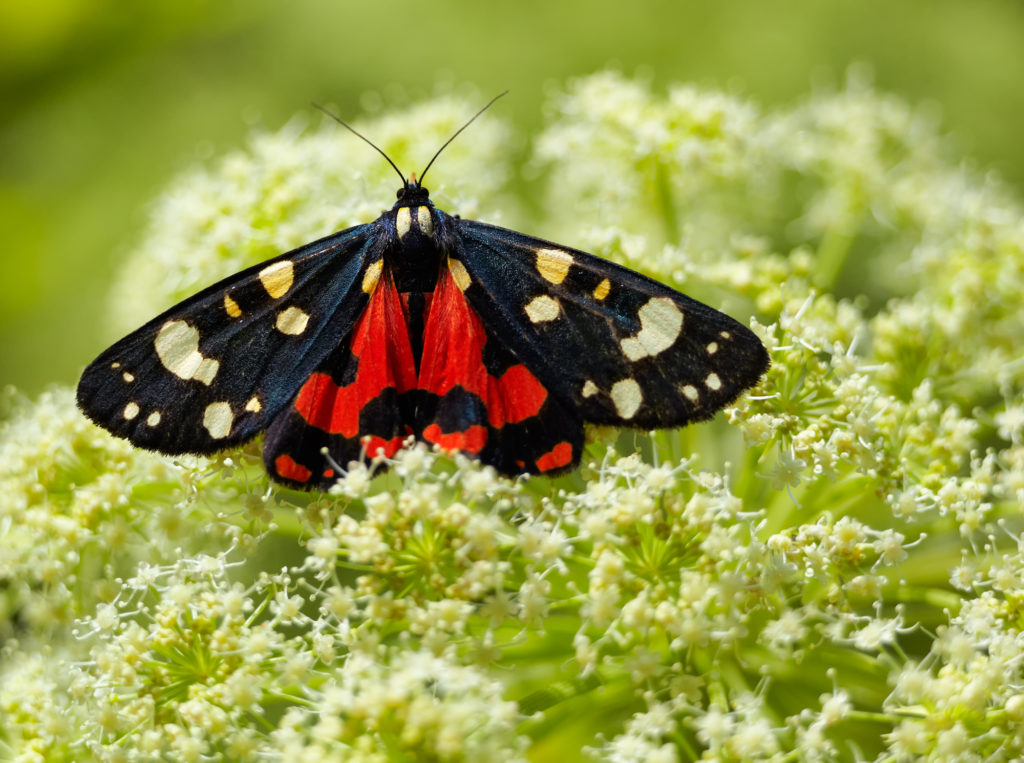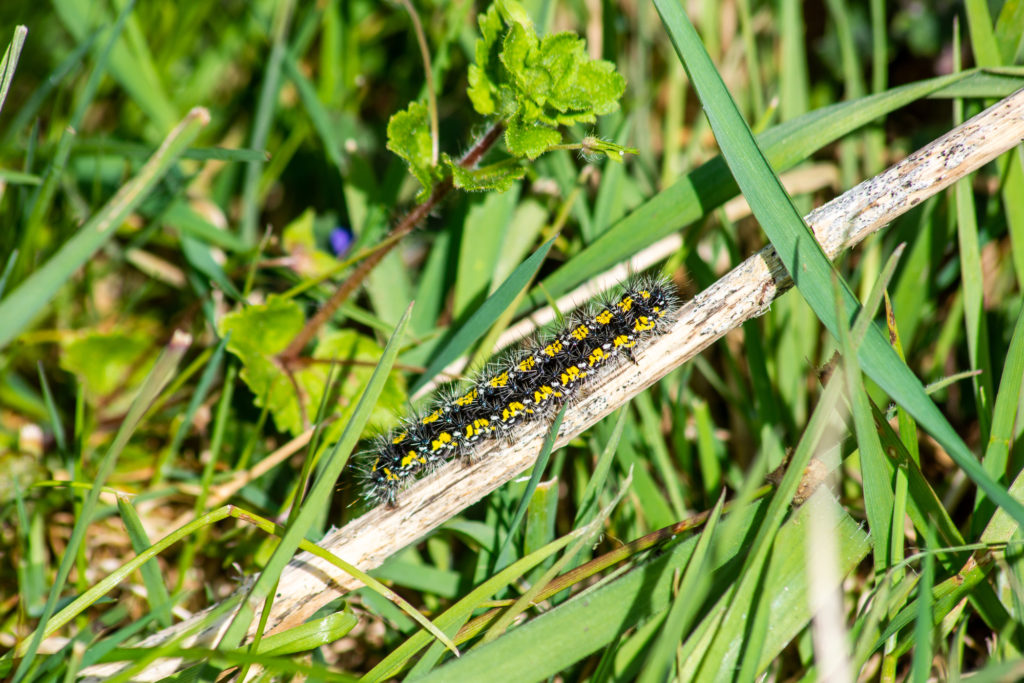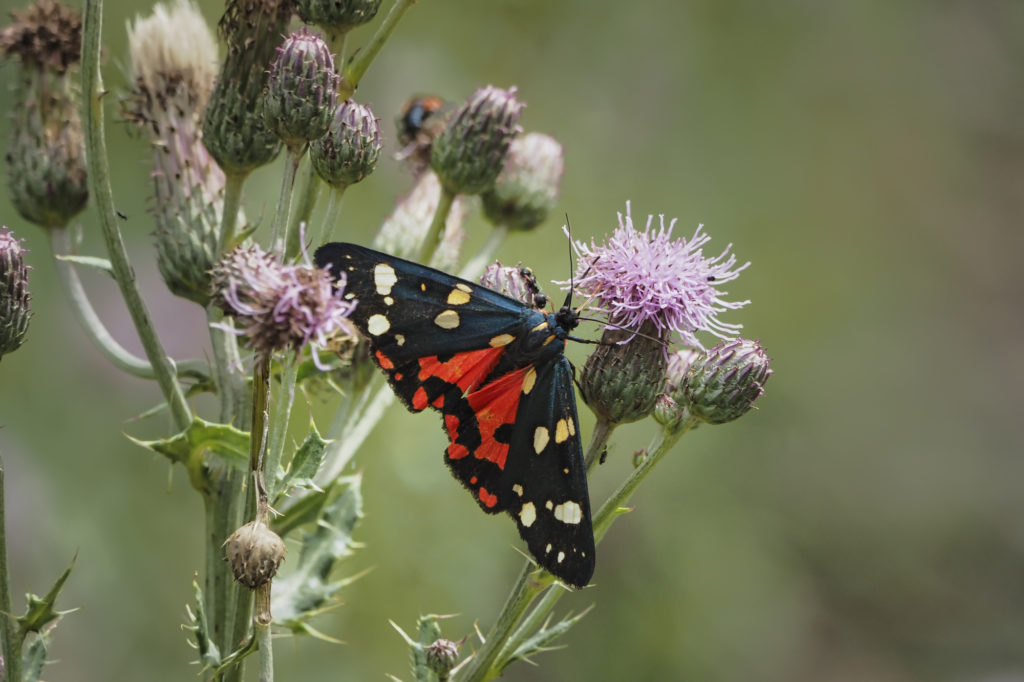The scarlet tiger (callimorpha dominula) is a beautiful moth that can be found in many parts of the UK. The day-flying species belongs to the family Arctiidae within the order Lepidoptera, which includes butterflies and moths around the world. It has a number of subspecies distinguished by their markings and location.
Other than its colouring, the scarlet tiger does not resemble any other UK moths making it easy to recognise if you find one flying around.
How To Identify a Scarlet Tiger Moth
The scarlet tiger is considered large, with a wingspan of 1.88 – 2.2 inches.
The adult tiger moth is easily identifiable by its colouring. However, the best way to distinguish this moth from other species is by its set of “eyespots” on its hind wings. The scarlet tiger is mostly black on the forewings (with yellow spots) and boasts deep orange hindwings (with black spots). The eyelike false eyespots are used to frighten off predators by making themselves appear larger than it actually is.
Occasionally you’ll see these rather variable adults with yellow hindwings. The black wings sometimes give off a metallic green sheen when looking at them in different lights.

Scarlet tiger caterpillars reach a length of approximately 1.6 inches. They are dark grey, sometimes almost black, with yellow and white dots on its side.

Where and When To See Them
Like its cousin the jersey tiger, scarlet tigers are also day-flying moths that can be spotted locally in parts of the UK. The single generation flies for about a month (sometimes just over), around the summer months of June and July.
Geographic
The scarlet tiger is mostly found in parts of South West England, West England, South Wales, and parts of North West England.
Habitat
Its habitat varies depending on what stage of life it is in. The Scarlet tiger moth is mostly seen in damp areas and rocky cliffs, but it can also be found in other habitats such as marshes, pastures, wetlands, oak thickets, and river banks, to name a few.
What Do Scarlet Tiger Moths Eat?
During the larval stage, the caterpillars feed on a variety of herbaceous plants ranging from common nettle to roses.
When the larva becomes an adult, the scarlet tiger moth can be found feeding on nectar at flowers such as goldenrod, black-eyed susan, hibiscus, verbenas and petunias. Scarlet tigers are one of the few tiger moths that have developed mouthparts that allow them to feed on nectar easily.

Scarlet Tiger Moth Lifecycle
The adults will only live a few weeks, spending the majority of their lives as caterpillars. In the spring, before the larva hatches, it will spend most of its life as an egg, where laving its egg case allows itself to become a chrysalis. Once inside the cocoon, the moth will remain for about four months, depending on how large it is when it emerges from its chrysalis.
Sources and References
- Scarlet Tiger moth (Callimorpha Dominula) – wildlifeinsight.com
- UK moths: nine of the most colourful and distinctive – nhm.ac.uk
Sam loves to learn about animals and their habitats. He has been a nature lover from a very young age, and has been writing papers and articles about wildlife for as long as he can remember.

I found one in my garden in the pavement it looked dead but when I tried to lift it.. It moved so have named to put it in a large bowl with a drop of honey diluted in water and it is moving. Will this help out? Is it at the end of its lifecycle?
Last year I saw several scarlet tigers moths in my garden. This Spring I saw 10-15 caterpillars on the borage which grows profusely around the garden. However, this month, June, I have only seen 5 dead moths, two with damaged wings and the other three apparently in good condition. I think it is too early for them to be dying naturally and wonder what is the cause. Any ideas and is there anything I can do to help them flourish next year?
Hello Sandra,
The decrease in scarlet tiger moths you observed could be due to natural population fluctuations, predators, parasites, or environmental changes. To help them flourish next year, add diverse plants to your garden and provide suitable habitats like log piles, leaf piles, or tall grasses.
Kind Regards
Saw one today in Melton Mowbray, Leicestershire apparently outside its usual territory.
Richard Cowdell
I forgot to say that I live in Reading, much further east than the places mentioned above
Seen several times in Cley, Norfolk last week
I found two scarlet tiger moths on my magnolia bush today.xx
We’ve just found one in our garden in Royston, Hertfordshire. So looks like they’re heading eastwards.
Just seen one in the garden, I live in mid Somerset.
I live in rural Oxfordshire and I have loads of them in my garden this year.
I have them most years but this year is incredible.
I had one on my fence so i put it amongst some flowers in my pot, not sure if it was the same one but my 5 year old grand daughter spotted one in the hedgerow about a week after. I live in Gawsworth,Macclesfield
I counted 5 in the garden today. I live in South Lincolnshire, between Grantham and Stamford.